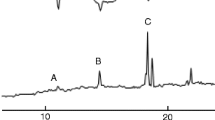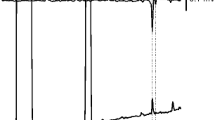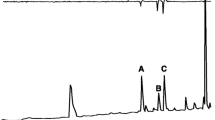Abstract
The sex pheromone of the western hemlock looper (WHL),Lambdina fiscellaria lugubrosa (Hulst), comprises three methylated hydrocarbons: 5,11-dimethylheptadecane (5,11), 2,5-dimethylheptadecane (2,5), and 7-methylheptadecane (7). Compounds extracted from female pheromone glands were identified by coupled gas chromatographic-electroantennographic (GC-EAD) analysis and coupled GC-mass spectroscopy in selected ion monitoring mode. In trapping experiments, (5,11) alone attracted male moths, but addition of either (7) or (2,5) significantly enhanced attraction. (5,11) combined with both (7) and (2,5) was significantly most attractive. (5,11) and (2,5) are also sex pheromone components of the eastern hemlock looper (EHL),Lambdina fiscellaria fiscellaria (Guen.). Although (7) is produced by the EHL, it is a pheromone component only in the WHL. It constitutes the first behaviorally active monomethyl-branched hydrocarbon to be found in a geometrid and is a novel lepidopteran sex pheromone component. The different 2- versus 3-component sex pheromone supports taxonomic division of EHL and WHL.
Similar content being viewed by others
References
Arn, H., Städler, E., andRauscher, S. 1975. The electroantennographic detector—a selective and sensitive tool in the gas chromatographic analysis of insect pheromones.Z. Naturforsch. 30c:722–725.
Bartell, R.J. 1982. Mechanism of communication disruption by pheromones in the control of Lepidoptera: A review.Physiol. Entomol. 6:889–892.
Bestmann, H.J., Brosche, T., Koscatzky, K.H., Michaelis, K., Platz, H., Roth, K., Suss, J., Vostrovsky, O., andKnauf, W. 1982. Pheromone-XLII. 1,3,6,9-Nonadecatraen, das Sexualpheromon des FrostspannersOperophtera brumata (Geometridae).Tetrahedron Lett. 23:4007–4010.
Bogenschütz, H., Knauf, W., Tröger, E.J., Bestmann, H.J., andVostrovsky, O. 1985. Pheromone 49: Freilandfänge von Geometriden-Männchen mit C19-Polyenen in Kiefernbeständen.Z. Angew. Entomol. 100:349–354.
Charmillot, P.-J. 1990. Mating disruption technique to control codling moth in western Switzerland, pp. 165–182,in R.L. Ridgway, R.M. Silverstein, and M.N. Inscoe (eds.). Behavior-Modifying Chemicals for Insect Management: Application of Pheromones and Other Attractants. Marcel Dekker, New York.
Dewey, J.E.,Ciesla, W.M., andLood, R.C. 1972. Status of the western hemlock looper in the Northern Region, 1972: A potentially devastating forest pest. USDA Forest Service Technical Report 72-10.
Flint, H.M., Curtice, N.J., andYamamoto, A. 1988. Pink bollworm (Lepidoptera: Gelechiidae): Further tests with (Z,Z)-isomers of Gossyplure.J. Econ. Entomol. 81:679–683.
Furniss, R.L., andCarolin, V.M. 1977. Western Forest Insects. USDA Forest Service Miscellaneous Publication No. 1339.
Gries, G., Gries, R., Borden, J.H., Jianxiong, Li, Slessor, K.N., King, G.G.S., Bowers, W.W., West, R.J., andUnderhill, E.W. 1991a. 5,11-Dimethylheptadecane and 2,5-dimethylheptadecane: Sex pheromone components of the geometrid moth,Lambdina fiscellaria fiscellaria.Naturwissenschaften 78:315–317.
Gries, G.,Jianxiong Li,Gries, R.,Slessor, K.N.,Bowers, W.W.,West, R.J.,King, G.G.S.,Underhill, E.W., andBorden, J.H. 1991b. Method and Composition for attracting and controlling hemlock looper. Canadian Patent Application #2,041,529-1.
Hansson, B.S., Scöcs, G., Schmidt, F., Francke, W., Löfstedt, C., andTóth, M. 1990. Electrophysiological and chemical analysis of the sex pheromone communication system of the mottled umber,Erannis defoliaria (Lepidoptera: Geometridae).J. Chem. Ecol. 16:1887–1897.
Harris, J.W.E., Collis, D.G., andMagar, K.M. 1972. Evaluation of the tree beating method for sampling defoliating forest insects.Can. Entomol. 104:723–729.
Krannitz, S.H. 1992. A synthetic sex pheromone for the western hemlock looper,Lambdina fiscellaria lugubrosa (Hulst) (Lepidoptera: Geometridae). MPM thesis. Simon Fraser University, Burnaby, British Columbia, Canada.
Li, J.,Gries, R.,Gries, G.,Slessor, K.N.,King, G.G.S.,Bowers, W.W., andWest, R.J. 1993a. Chirality of 5,11-dimethylheptadecane, the major sex pheromone component of the hemlock looper,Lambdina fiscellaria (Lepidoptera: Geometridae).J. Chem. Ecol. In press.
Li, J.,Gries, G.,Gries, R., Bikic, J., andSlessor, K.N. 1993b. Chirality of synergistic sex pheromone components of the western hemlock looper,Lambdina fiscellaria lugubrosa (Hulst) (Lepidoptera: Geometridae).J. Chem. Ecol. Submitted.
Linn, C.E., Jr., Campbell, M.G., andRoelofs, W.L. 1986. Male moth sensitivity to multicomponent pheromones: Critical role of female released blend in determining the functional role of components and active space of the pheromone.J. Chem. Ecol. 12:659–668.
Linn, C.E., Jr., Campbell, M.G., andRoelofs, W.L. 1987. Pheromone components and active spaces: What do moths smell and where do they smell it?Science 237:650–652.
McGuffin, W.C. 1987. Guide to the Geometridae of Canada (Lepidoptera). II. Subfamily Ennominae. 4.Mem. Entomol. Soc. Can. 138:64–65.
Mayer, M.S., andMcLauohlin, J.R. 1991. Handbook of Insect Pheromones and Sex Attractants. CRC Press, Boca Raton, Florida.
Meidinger, D., andPojar, J. 1991. Ecosystems of British Columbia. British Columbia Ministry of Forestry Special Report Series No. 6.
Miller, J.G., Underhill, E.W., Giblin, M., andBarton, D. 1987. Sex pheromone components of three species ofSemiothisa (Geometridae), (Z,Z,Z)-3,6,9-heptatriene and two monoepoxydiene analogs.J. Chem. Ecol. 13:1371–1383.
Millar, J.G., Giblin, M., Barton, D., Reynard, D.A., Neill, G.B., andUnderhill, E.W. 1990a. Identification and field testing of female-produced sex pheromone components of the spring cankerworm,Paleacrita vernata Peck (Lepidoptera: Geometridae).J. Chem. Ecol. 16:3393–3409.
Millar, J.G., Giblin, M., Barton, D., andUnderhill, E.W. 1990b. (3Z,6Z,9Z)-Nonadecatriene and enantiomers of (3Z,9Z)-cis-6,7-epoxy-nonadecadiene as sex attractants for two geometrid and one noctuid moth species.J. Chem. Ecol. 16:2153–2166.
Millar, J.G., Giblin, M. Barton, D., andUnderhill, E.W. 1990c. (3Z,6Z,9Z)-Trienes and unsaturated epoxides as sex attractants for geometrid moths.J. Chem. Ecol. 16:2307–2316.
Millar, J.G., Giblin, M., Barton, D., Morrison, A., andUnderhill, E.W. 1990d. Synthesis and field testing of enantiomers of (6Z,9Z)-cis-3,4-epoxydienes as sex attractants for geometrid moths. Interactions of enantiomers and regioisomers.J. Chem. Ecol. 16:2317–2339.
Millar, J.G., Giblin, M., Barton, D., andUnderhill, E.W. 1992. Sex pheromone components of the geometrid mothLobophora nivigerata andEpirrhoe sperryi.J. Chem. Ecol. 18:1057–1068.
Minks, A.K. andCardé, R.T. 1988. Disruption of pheromone communication in moths: Is the natural blend really most effective?Entomol. Exp. Appl. 49:25–36.
Ostaff, D.P., Shepherd, R.F., andBorden, J.H. 1974. Sex attraction and courtship behavior inLambdina fiscellaria lugubrosa (Lepidoptera: Geometridae).Can. Entomol. 106:493–501.
Otvos, I.S. 1972. Sex attraction in the eastern hemlock looper.Bimon. Res. Notes 28:22.
Otvos, I.S. 1974. A collection method of pupae ofLambdina fiscellaria fiscellaria (Lepidoptera: Geometridae).Can. Entomol 106:329–331.
Pomonis, J.G., Nelson, D.R., andFlatland, C.L. 1980. Insect hydrocarbons. 2. Mass spectra of dimethylalkanes and the effect of the number of methylene units between methyl groups on fragmentation.J. Chem. Ecol. 6:965–987.
Roelofs, W.L. 1978. Threshold hypothesis for pheromone perception.J. Chem. Ecol. 4:685–699.
Roelofs, W.L., andBrown, R.L. 1982. Pheromones and evolutionary relationships of Tortricidae.Annu. Rev. Ecol. Syst. 12:395–422.
Roelofs, W.L. andComeau, A. 1969. Sex pheromone specificity: Taxonomic and evolutionary aspects in Lepidoptera.Science 165:395–400.
Roelofs, W.L., Hill, A.S., Linn, C.E., Jr. Meinwald, J., Jain, S.C., Herbert, H.J., andSmith, R.F. 1982. Sex pheromone of the winter moth, a geometrid with unusually low temperature precopulatory responses.Sciences 217:657–659.
Rothschild, G.H.L. 1981. Mating disruption of lepidopteran pests: current status and future prospects, pp. 207–228,in E.R. Mitchell (ed.). Management of Insect Pests with Semiochemicals: Concepts and Practice. Plenum, New York.
Shepherd, R.F. 1979. Comparison of the daily cycle of adult behavior of five forest lepidoptera from Western Canada, and their response to pheromone traps.Mitt. Schweiz. Entomol. Gesell. 52:157–168.
Shore, T.L. 1989. Sampling western hemlock looper pupae (Lepidoptera: Geometridae) using burlap traps.J. Entomol. Sci. 24:348–354.
Shore, T.L. 1990. Recommendations for sampling and extracting the eggs of the western hemlock looper,Lambdina fiscellaria lugubrosa (Lepidoptera: Geometridae).J. Entomol. Soc. B.C. 87:000.
Struble, D.L., andArn, H. 1984. Combined gas chromatography and electroantennogram recording of insect olfactory responses, pp. 161–178,in H.E. Hummel and T.A. Miller (eds.). Techniques in Pheromone Research. Springer, New York.
Szöcs, G., Tóth, M., Bestmann, H.J., andVostrowsky, O. 1984. A two-component sex attractant for males of the geometrid mothAlsophila quadripunctata.Entomol. Exp. Appl. 36:287–291.
Turnquist, R. 1991. Western hemlock looper in British Columbia. Forestry Canada Pacific and Yukon Region, FIDS Report 91-8.
Underhill, E.W., Millar, J.G., Ring, R.A., Wong, J.W., Barton, D., andGiblin, M. 1987. Use of a sex attractant and an inhibitor for monitoring winter moth and Bruce spanworm populations.J. Chem. Ecol. 13:1319–1329.
Wong, J.W., Palaniswamy, P., Underhill, E.W., Steck, W.F., andChisholm, M.D. 1984. Novel sex pheromone components for the fall cankerworm moth,Alsophila pometaria.J. Chem. Ecol. 10:463–473.
Wood, C.S. andVan Sickle, G.A. 1992. Forest insect and disease conditions: British Columbia and Yukon-1991. Forestry Canada, Pacific and Yukon Region, Information Report BC-X-334.
Author information
Authors and Affiliations
Rights and permissions
About this article
Cite this article
Gries, G., Gries, R., Krannitz, S.H. et al. Sex pheromone of the western hemlock looper,Lambdina fiscellaria lugubrosa (Hulst) (Lepidoptera: Geometridae). J Chem Ecol 19, 1009–1019 (1993). https://doi.org/10.1007/BF00992534
Received:
Accepted:
Issue Date:
DOI: https://doi.org/10.1007/BF00992534




